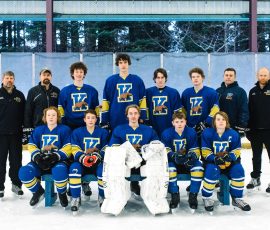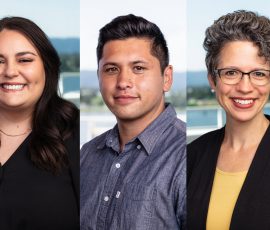Eligibility Guidelines for Grantseekers
ELIGIBILITY GUIDELINES FOR GRANTSEEKERS
The M. J. Murdock Charitable Trust seeks to build capacity in nonprofits driving innovative and sustainable outcomes across the Pacific Northwest that serve the common good.
Funding Region
The Trust prioritizes its grants to organizations based in Alaska, Idaho, Montana, Oregon, Washington or those with projects that directly impact this region. A small number of grants are made beyond this region to a by-invite-only national and global portfolio.
Funding Priorities
The Trust focuses its strategic grant funding on projects that contribute to human flourishing, enhancing nonprofit organizational capacity and furthering mission-focused impact to the Pacific Northwest. Eligible projects reflect the strategic priorities of an organization’s leadership and align with the Murdock Trust’s sectoral strategies and priorities.
Submission Frequency
Returning grantees may submit a new letter of inquiry two years after their last award date. Declined applicants may submit a new letter of inquiry for a different project six months after decision date.
Grant Sizes
Dollar amounts vary by sector, organization, and project. Proposals for projects with budgets below $100,000, with request amounts less than $50,000, are highly discouraged. It may be helpful to review past grants on the Trust’s Grants Awarded page to determine the range of award sizes.
Funding Limitations
While the Trust is dedicated to supporting organizations and projects based in the Pacific Northwest, it is important to be aware of other eligibility limitations.
Entity Types
A grant applicant must be one of the following types of entities:
- A nonprofit organization recognized as a tax-exempt public charity under Section 501(c)(3) of the Internal Revenue Code of the United States. A nonprofit organization applying for support must verify the possession of the most current IRS documentation (“determination letter”) reflecting its status as a public charity. Partnerships and related-party agreements do not take the place of an organization having its own U.S. 501(c)(3) determination.
- A federally recognized tribal entity.
- A government entity such as a university or a medical center, but please note that only certain governmental entities are eligible under these guidelines. See limitations set forth below.
The following types of entities are not eligible:
- Fiscally sponsored organizations
- Governmental entities that receive a substantial amount of government funding, such as public libraries, public K-12 school districts, public charter schools, public parks and recreation, fire departments, fire districts, and police stations
- Section 501(c)(4) organizations (advocacy or social welfare organizations)
- Section 501(c)(6) organizations (business leagues, chambers, and trade associations)
- Section 509(a)(3) supporting organizations – regardless of type
- Churches, synagogues, mosques, and other places of worship that do not have a separate 501(c)(3) status and an independent governance board for external programs
- Private foundations (non-operating) – what is this?
- Non-U.S. entities
- Individuals
- Senior centers, hospice organizations, and other services for the aging
- For-profit business, corporation, or LLC
Additional Entity Restrictions
The following entities are not eligible:
- Entities with fewer than three complete years of operating and financial history
- Entities that, in policy or practice, unlawfully discriminate based on race, ethnic origin, sex, creed, or religion
- Entities that receive a majority of funding and support from commercial gambling revenue (lottery, casino, etc.)
Project Restrictions
The following types of funding requests are not eligible for strategic grants:
- Funding of standard or ongoing operational costs, including existing staff time
- Funding to continue existing projects that have been financed from external sources
- Long-term loans, debt retirement, or funding for operational deficits
- Funds that will ultimately be passed through to other organizations or individuals
- Standalone requests for short-lived projects, initiatives, or seasonal programs such as event sponsorships, consulting, honorariums, or contract staffing
- Standalone requests for planning or research such as study-based projects, surveys or focus groups, assessments, or stipends
- Projects with funding plans with revenue from high levels (50 percent or more) of commercial gaming revenue (e.g., lottery, casino, etc.)
- Endowments or revolving funds that function as such
- Urgent needs, emergency funding, or gap funding
Organizations and Projects with Government Funding
Data shows that diversified funding is a cornerstone of successful, sustainable nonprofit organizations. Organizations that build on diversified funding sources are well-positioned to navigate economic shifts and demonstrate broad community support. Given the Murdock Trust’s focus on providing capacity-building support to established nonprofits, the Trust prioritizes organizations and projects with demonstrated diversification in their funding profile.
One consideration within this approach is the level of government funding received by an organization.
- The Trust does not generally fund government institutions such as public school districts or libraries. Exceptions to this include select entities, such as universities (scientific research), medical centers, and historical societies.
- Tribal government entities are eligible for funding from the Trust.
- As a general policy, capital projects with government sources contributing 70 percent or more of the required funding are ineligible for a grant. Sustained staff positions must receive no more than 50 percent of funding from government sources.
The Trust does fund projects and organizations that obtain significant funding from government sources if they are related to business transactions. For example,
- In cases where the government is a direct customer of services provided by the nonprofit such as youth skill development groups, refugee service providers, or youth forestry service providers
- Organizations receiving Medicare or Medicaid reimbursement through patients
- Mental health and social service providers with fees for services (contracts)
Board Engagement Expectations
A grant applicant must be able to demonstrate significant board engagement. Engagement is measured by three primary metrics:
- Time (attendance and engagement at board meetings, volunteering, cultivating donors)
- Treasure (direct financial support, securing other funding, access to networks, in-kind donations)
- Talents (wisdom, leadership, experience, or expertise)
If the proposed project includes funding for fundraising staff, then significant engagement and financial support by the board (governance or fundraising board and committees) is required as that commitment is a key factor for project success.
Strategic Project Grant Types
A strategic project grant request should be centered around one grant type. Please review the guidelines for each of the three strategic grant types before proceeding.
New Staff or Program Expansion Grants
Program and staff grants support new programs or the expansion of existing programs and may be used to cover start-up costs and/or related staff member additions. The grant is structured on a declining basis over three years (100/67/33%).
- Hired staff or programs initiated prior to the Trust site visit are not eligible for funding. Funding is not guaranteed if requested position(s) or programs are already initiated.
- For organizations located outside the Trust’s region, positions or programs must bring substantial impact to the Northwest (at least 50% project impact).
- Requests for added staff capacity are limited to no more than 2.0 full-time equivalency (FTE). For comprehensive, focused program expansion requests, the Trust may consider more than 2.0 FTE and a portion of new program costs.
- Requests must constitute an addition or increase of permanent, strategic positions with a minimum of 0.5 FTE per position.
- Requests for administrative support positions are generally ineligible.
- Grants are not made for positions that previously existed less than 5 years prior to the Trust request.
- Program and/or staff requests may include new startup technology costs.
- Positions or programs sustained with revenues of more than about 50 percent* from government funding are ineligible.
*50 percent does not include positions or programs that are sustained with fee-based reimbursements or ongoing public contract revenue.
Guidelines for Fundraising Positions
- The Trust anticipates a return on investment (ROI) with new funds raised that, at a minimum, double the cost of the position after the grant is complete (Year 4). The return on investment will be analyzed based on the size and context of the organization.
Example: Y1 Development Director Cost = $80,000 / Y4 ROI revenue = $160,000 or more
- Applicant’s leadership is currently implementing an organized development effort.
- Board giving should reflect a spirit of philanthropy in the organization.
- Organizational leadership should reflect engagement in fund development.
Capital Grants
Capital project grants support construction, renovation, land or property purchase, leasehold improvements, and other capital upgrades.
- Trust preference is that the organization has raised a minimum of 40 percent of the total capital cost prior to Trustee decision and has a viable plan to complete project funding.
- A diversified funding plan with a demonstration of community support is expected.
- If the operating facility is government-owned, equipment and technology grant requests are preferred.
- Tenant leasehold improvement projects require a minimum 10-year lease agreement.
The following types of capital requests are not eligible:
- Long-term debt repayment
- Routine maintenance of short-life items or deferred capital replacements which do not significantly transform programs, operations, or capacity
- Projects that are funded with more than 70 percent from government funding
- Direct fundraising expenses, feasibility studies, or costs for existing staff time
Eligible Capital Costs
- Hard Costs: Eligible hard costs include construction labor and materials, site upgrades, landscaping, utility or system installation, and FF&E (furniture, fixtures, and equipment).
- Soft Costs: Eligible soft costs include architectural or engineering services, site analysis, permitting, taxes, or external project management (existing staff time ineligible).
- Property Acquisition: The property to purchase must be identified by the time of application and the closing date for purchase must occur after a grant has been awarded.
Equipment and Technology Grants
Only requests for equipment or technology new to the organization will be considered. Grantees must be responsible for 50 percent or more of the purchase cost.
- Routine or deferred maintenance that are stand-alone items (not a part of a major facility renovation, facility expansion, or new facility purchase), are not eligible.
- Physical equipment with a preferred life expectancy of 10 or more years. Equipment with shorter life expectancy should include an equipment replacement plan.
- Equipment or technology may be ordered with a deposit prior to Trustee action. Fully purchased equipment or technology will not be reimbursed.
- Request may include costs for consultant training for equipment or technology.
- Up to one year of maintenance costs may be included in the request.
- Both replacement and maintenance plans are expected for technology projects.
Sector Guidelines and Limitations
The Trust serves a wide breadth of organizations and sectors across the Pacific Northwest region. Please review the list of request constraints for specific entities or subsectors. Any unlisted entity categories or subsectors do not have limitations within general grant eligibility.
Arts, Culture, & Education
Enriching Lives and Igniting Pathways
Arts and Culture
- Media—Prefer requests for capital or equipment for new technology or service area expansion, particularly rural-serving.
- Performing Arts—Requests to support individual artists or a season/body of work are not eligible.
- Visual Arts—Public visual art projects with unique, historical, and regional impact are preferred.
Education
Requests for classroom teaching staff, professional, or curriculum development are typically not granted.
- Camps
- For national organizations with multiple locations, only one proposal should be submitted at a time. A pre-selected primary point of contact by the nonprofit’s national organization will facilitate the timing of proposal review.
- Sectarian camps (church denominations) must show that at least 30 percent of the service population are from outside their immediate faith community or denomination.
- Early Childhood Education (ECE)—Organizations and projects must have educational components, (beyond just childcare, with programs and curriculum for language learning and socio-emotional development).
- Higher Education
- Private Undergraduate Institutions—Eligible for one of the president’s highest strategic priorities for capital or equipment and technology
- A minimum of 100 students enrolled (total) for private colleges.
- Informal Education—Focused on supporting student success. Prefer nonprofits that offer in-school or after-school programming that supplement (not replace) the work of K-12 education staff.
- Museums, Zoos, and Aquariums—Prefers regional-serving organizations and permanent exhibits (expected lifecycle of 10 years or more). Short-term or traveling exhibits are rarely supported.
- Private K-12
- Enrollment minimum requirements by state…
- Oregon and Washington: 200 or more
- Alaska, Idaho, and Montana: 150 or more
- Prefer equipment and technology or capital requests for sciences or arts.
- Requests for staff or program grants are limited to development expansion.
- Private K-12 schools must show that at least 30 percent of the student population are from outside of their immediate faith community or denomination.
Health & Environmental Stewardship
Promoting Sustainability
Health
- Hospitals and Clinics
- Prefer request for capital projects focused on revenue generating areas (e.g., emergency rooms, surgical suites, diagnostic and therapeutic equipment). Staff positions in this space are generally ineligible except for senior or strategic positions.
- Regional Hospitals— Only hospitals with fewer than 100 beds are eligible. Large metropolitan hospitals are not eligible.
- Rural Hospitals—Those with fewer than 100 acute beds are eligible.
- Humane Societies or Animal Shelters—Prefer state-wide, multi-county, or regional reach. Entities must conduct research or have significant mental health components.
- Mental Health—Prefer those with models grounded in current knowledge of best practices and offering wrap-around or upstream services.
Environmental Stewardship
- Natural Resource Protection and Education—Prefer organizations with a wider regional reach that encourage stewardship and working lands approach.
- Land Trusts—Prefer land trusts that are accredited and pursuing projects with regional reach, organizations with multiple areas of expertise and capable of complex transactions.
- Community Land Trusts (CLT)—Focused on permanently affordable properties.
The following entities are not eligible:
- Local watershed councils
- Local green infrastructure or energy organizations without regional impact
Civic Engagement & Community Services
Foundations for Human Flourishing
Community Services
- Domestic Violence & Human Exploitation Services—Organizations with upstream prevention programs are the focus.
- Financial Assistance—Prefer programs that demonstrate a clear path to transformation or stability (not rental assistance or emergency funding)
- Food Insecurity—Prefer food banks with state-wide, multi-county, or regional reach—serving large population service areas; prefer capital and equipment requests.
- Homeless Services—Organization and project should demonstrate a clear path to transformation or stability.
- Legal Services—Projects that include Court Appointed Special Advocates (CASA) require regional, multi-county, or state-wide impact.
- Low-Income Housing—Prefer housing projects that provide emergency shelter, recovery, or transitional housing.
Scientific Research (Strategic Projects Only)
Fostering Innovation
- Community Colleges/Technical Schools—Limited to privately funded schools and two-year Tribal colleges open to dental and nursing programs (those that offer public-facing health services), and select workforce development programs, particularly those in technology. Limit to those that align with the sector’s strategy and priorities.
- Private Undergraduate Institutions—Eligible for one of the president’s highest strategic priorities for capital, equipment, and technology projects in STEM or allied health education. Smaller institutions may be eligible for senior or strategic staff positions and programs.
- Select Biomedical Research Institutions—Occasionally consider requests for special projects other than scientific research.
- Tier 1 – Public Universities—Occasionally consider requests for special projects other than scientific research.
- Tier 2 – Public Universities—Limited to scientific research support.
Application resources and guidelines can be found on the sector’s webpage for Scientific Research Projects and Scientific Research Initiatives.








